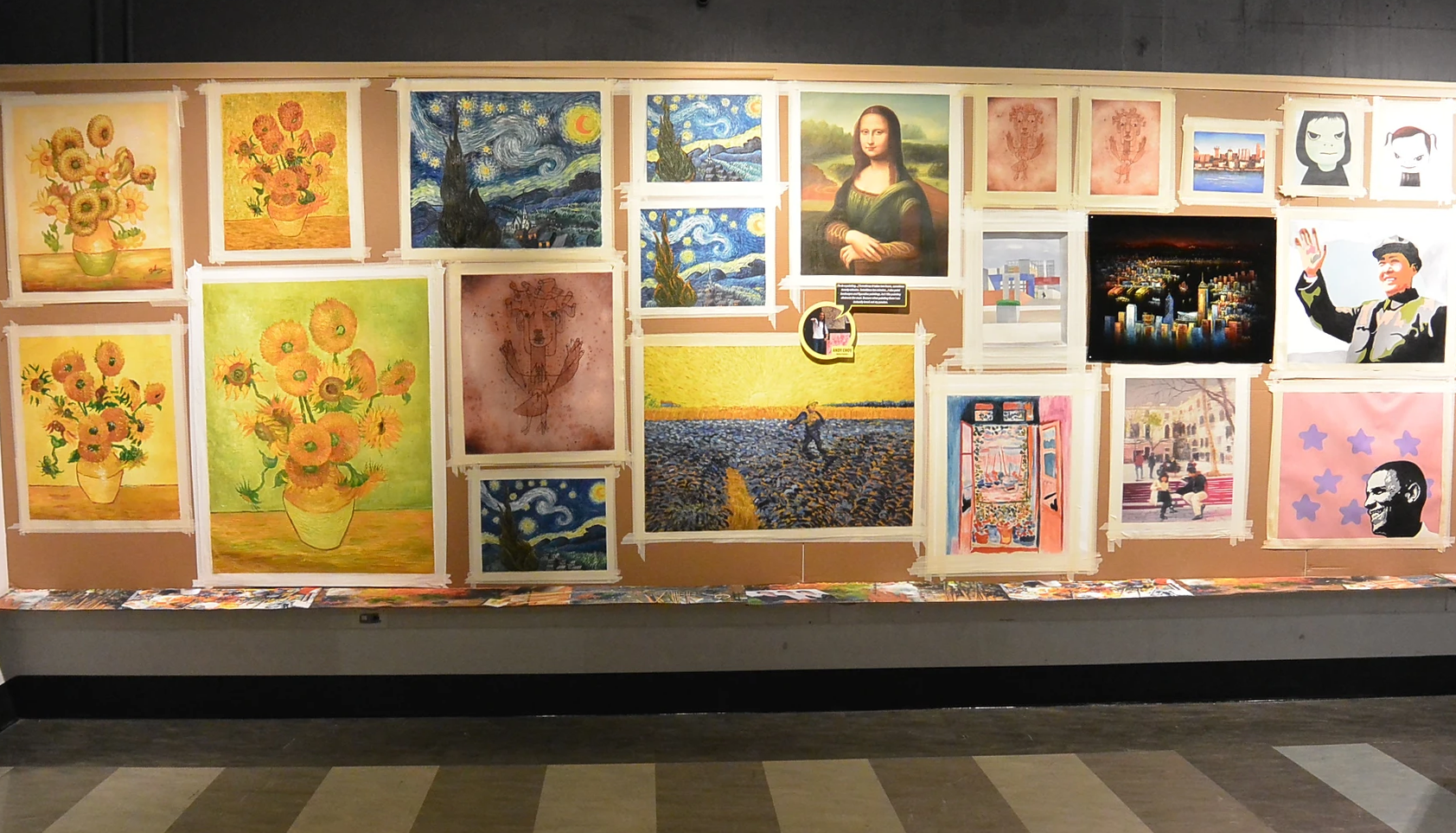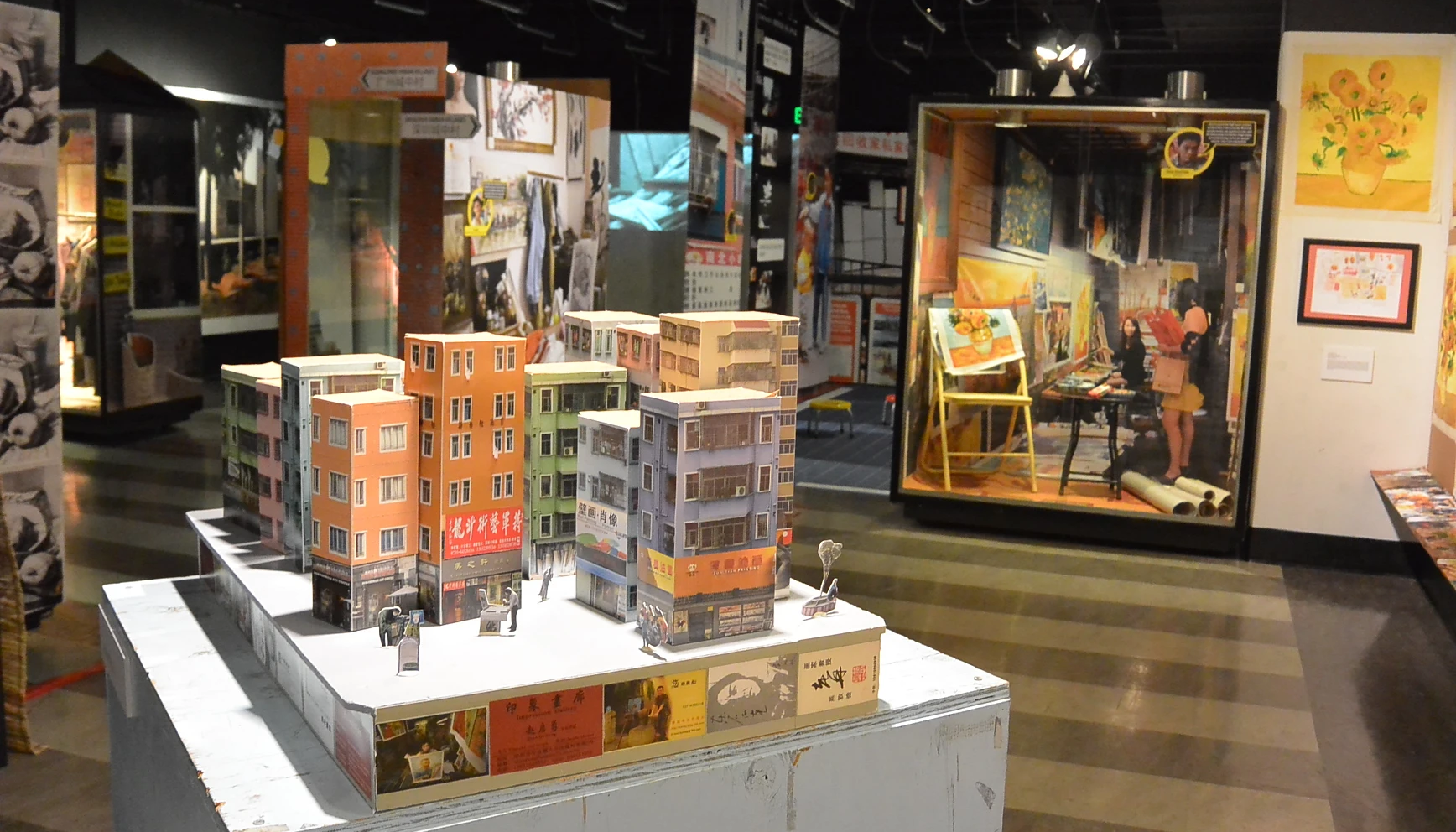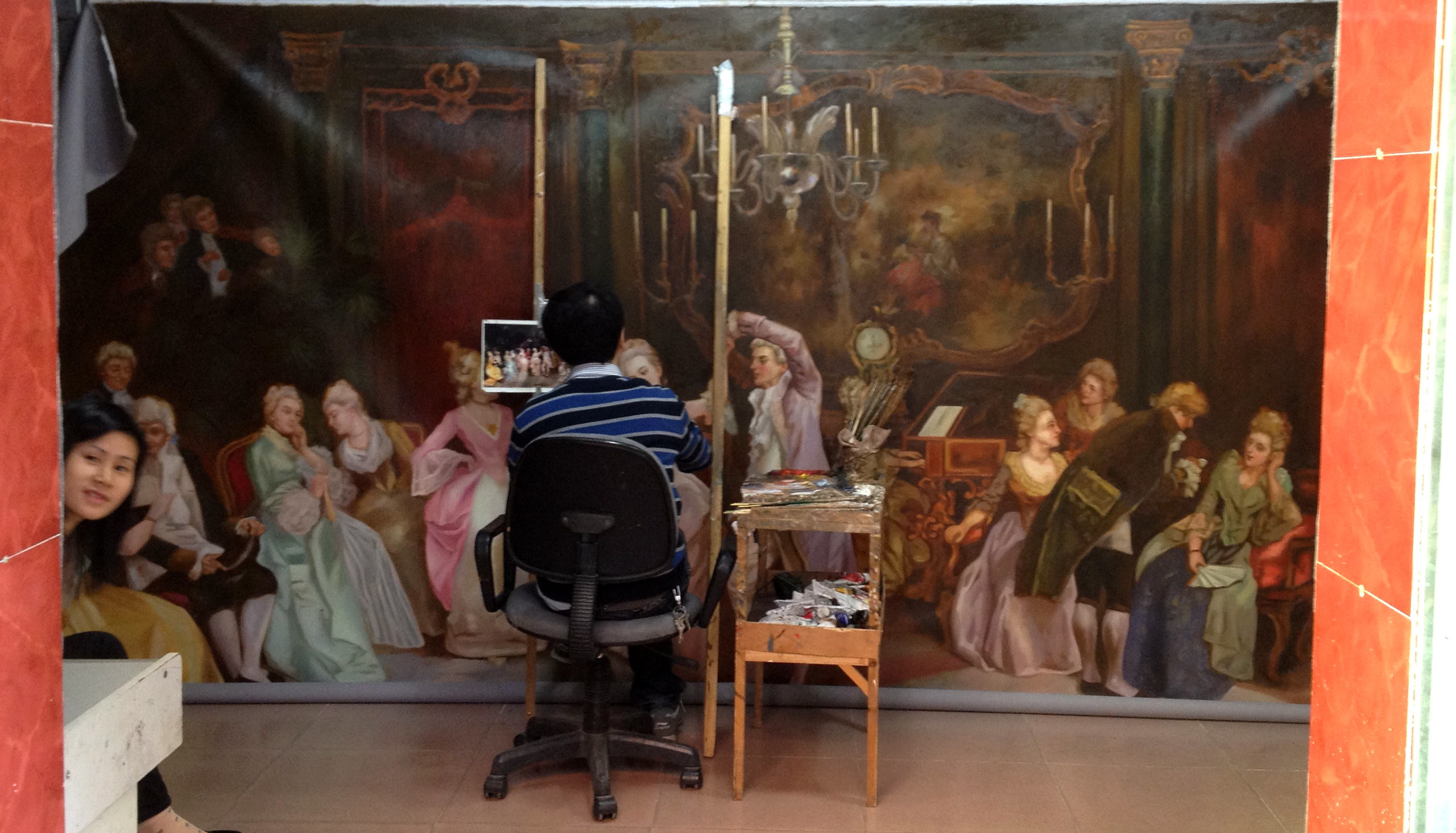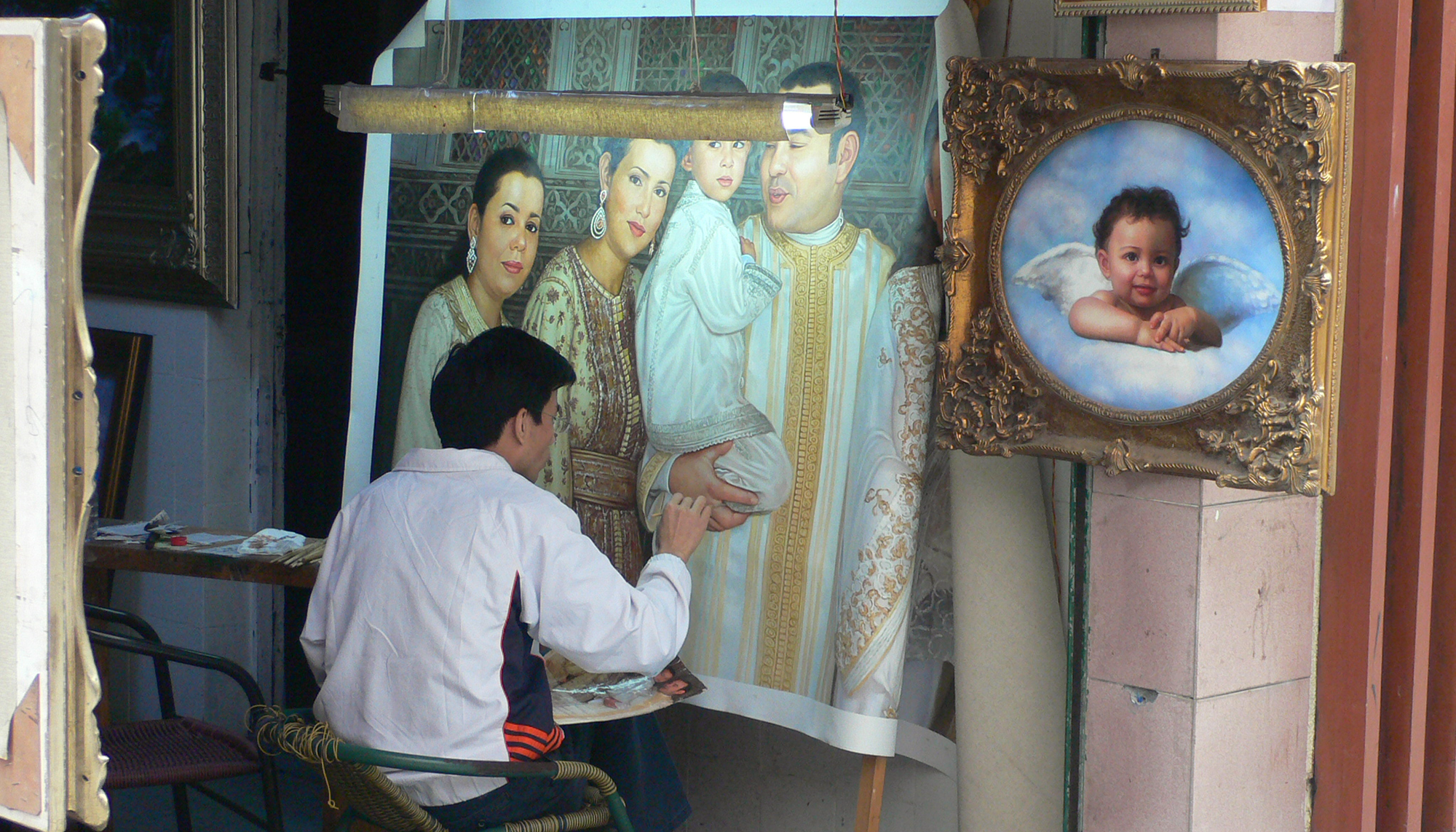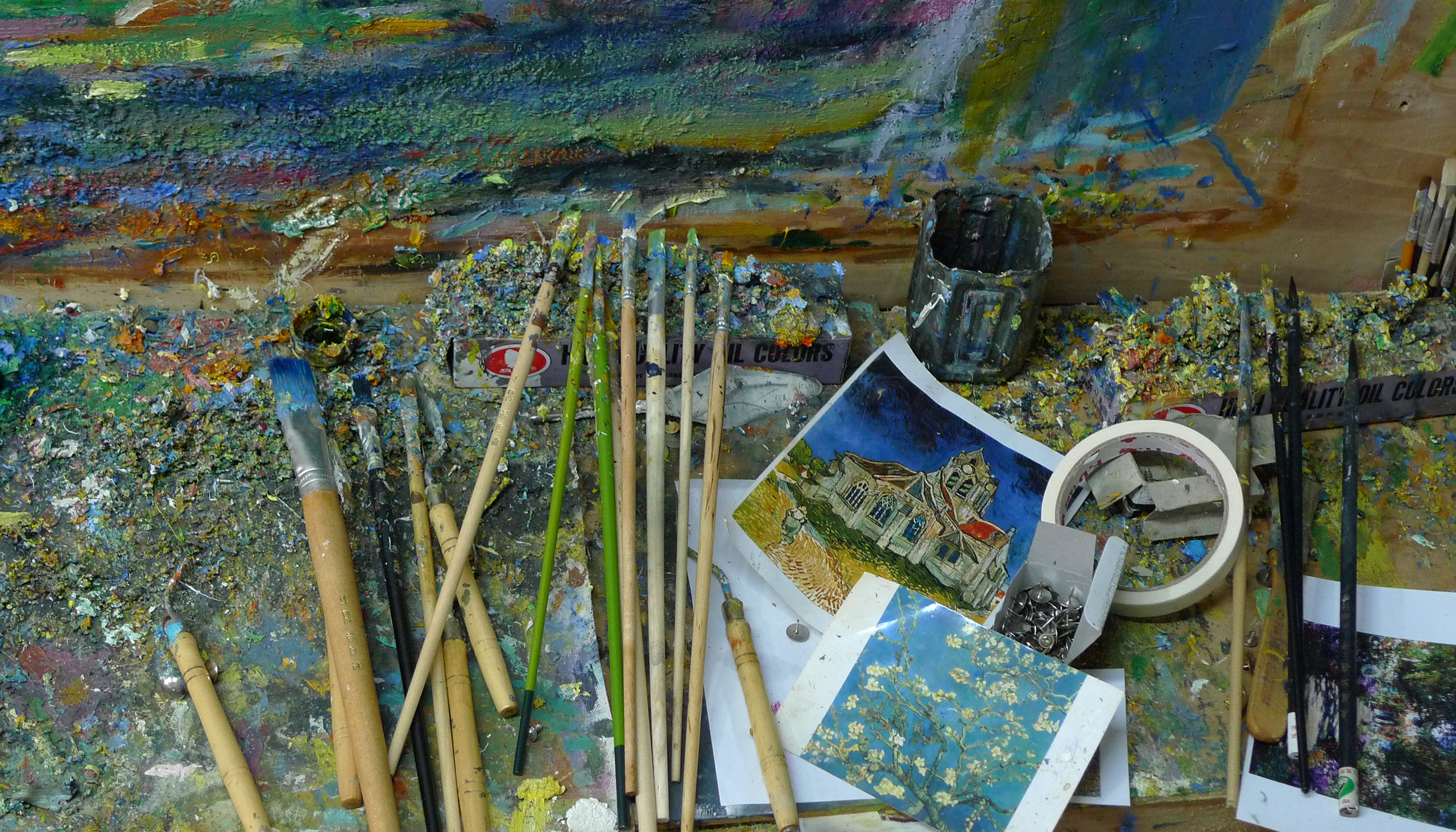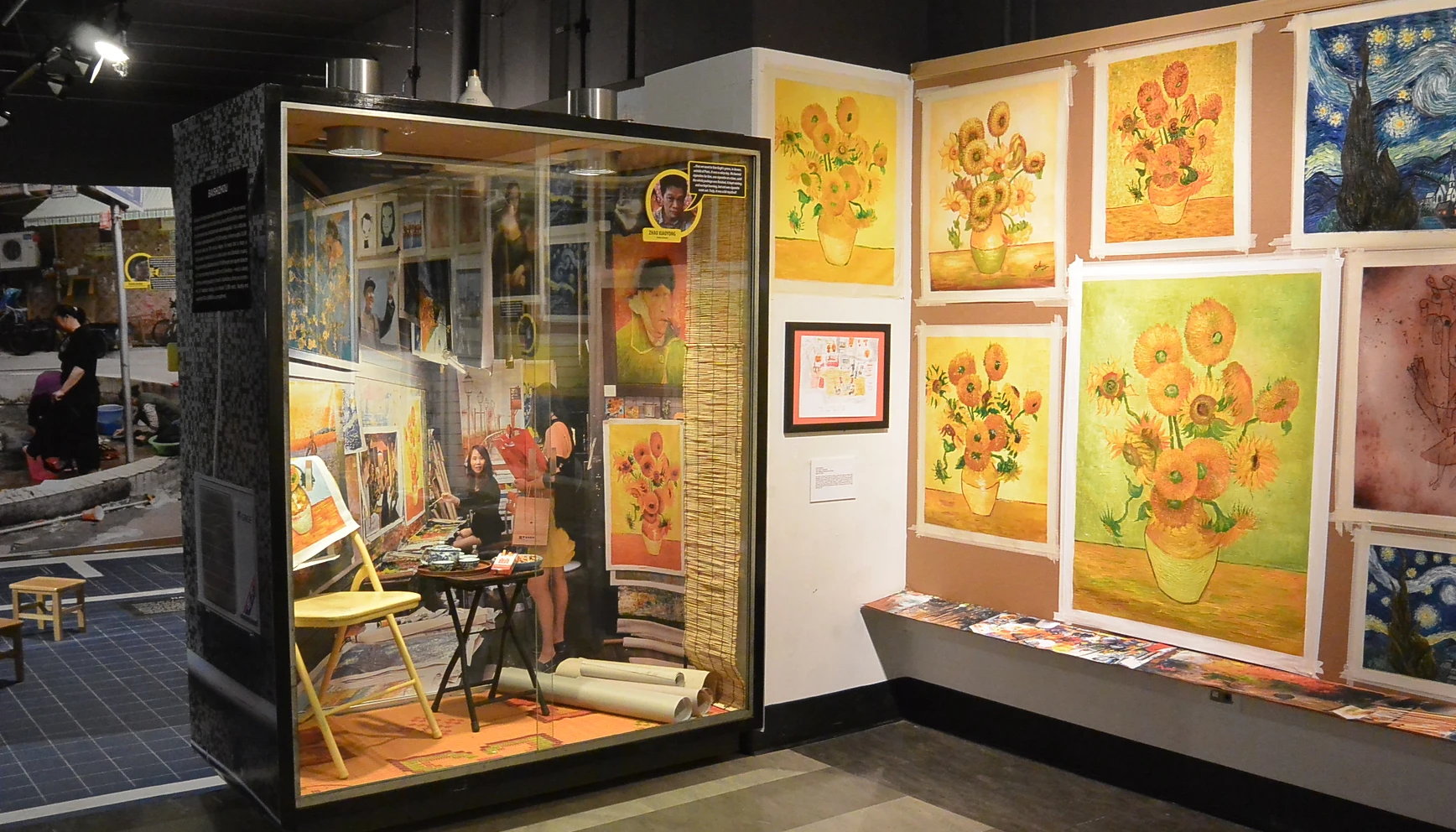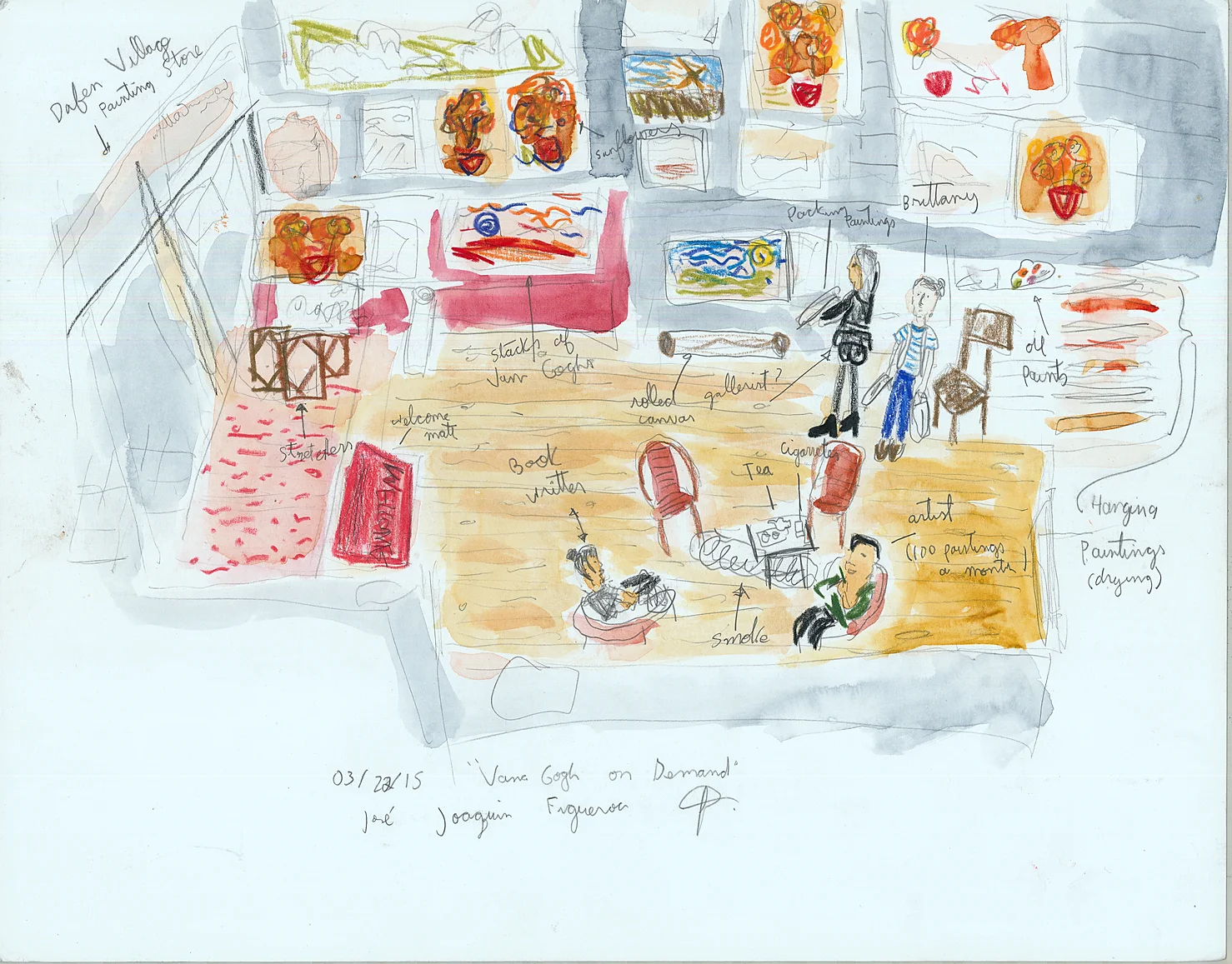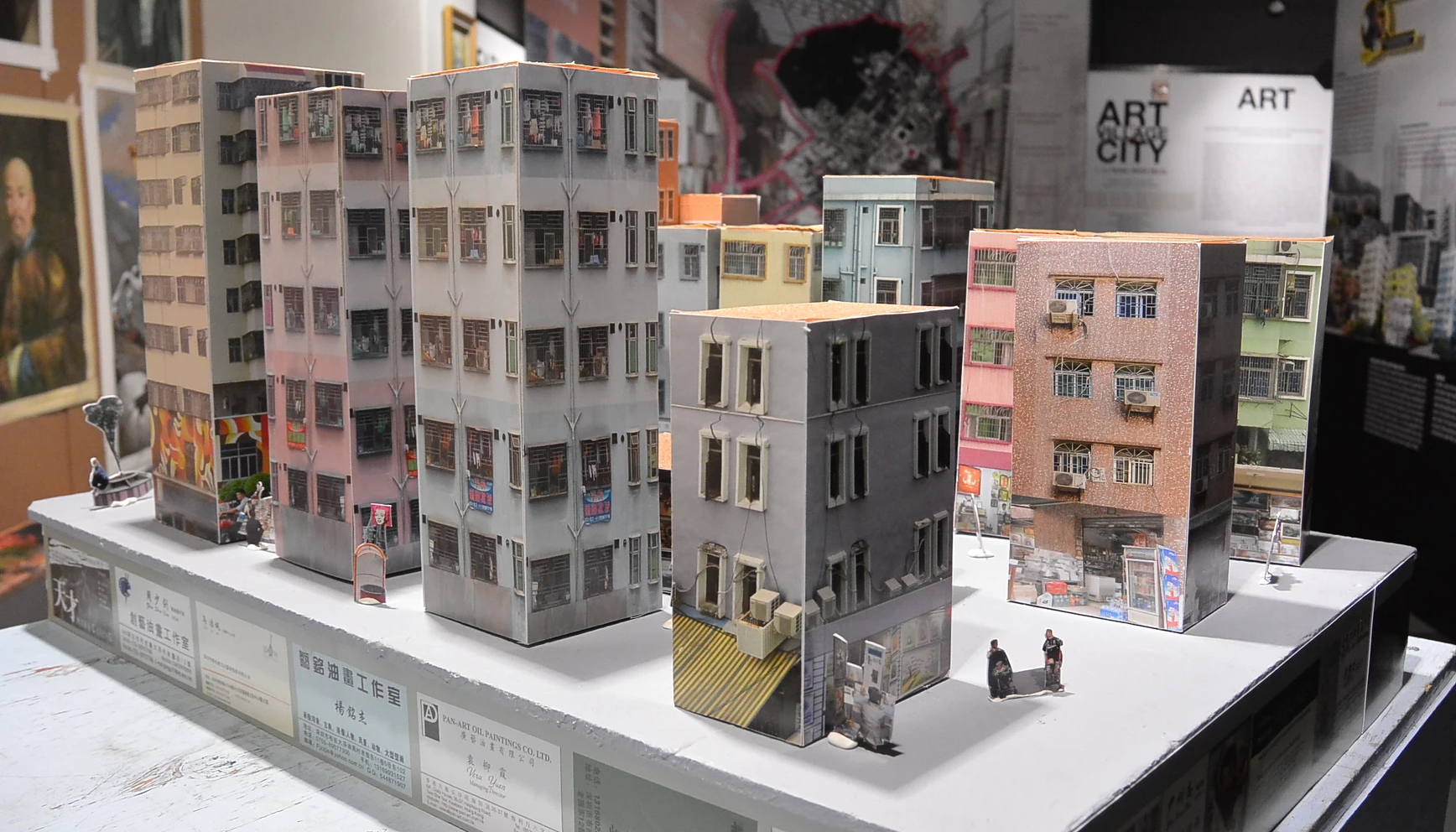Berkeley Voices: Fakes, replicas and forgeries: What counts as art?
In the early 2000s, UC Berkeley rhetoric professor Winnie Wong visited Dafen village in China, where artists painted replicas of famous pieces like the Mona Lisa and Starry Night. It dramatically changed how she thinks about art and those who make it.
March 31, 2025
Key takeaways
- The reality of replica painting in China is more complex and nuanced than the stereotypical image of assembly-line factories.
- There is much greater similarity between the most successful artists and the most accused forger than many of us imagine.
- The anxiety around AI-generated art today parallels earlier concerns about globalization and outsourcing of manufacturing. Both challenge traditional notions of creativity, originality and the value of human-made art.
Follow Berkeley Voices, a Berkeley News podcast about the people and research that make UC Berkeley the world-changing place that it is. Review us on Apple Podcasts.
When Winnie Wong first saw Dafen Oil Painting Village in 2006, it was nothing like she’d imagined.
The Chinese village was known for mass producing copies of Western art. She’d read about it in The New York Times, which described a kind of compound where thousands of artists painted replicas of famous artworks, like da Vinci’s Mona Lisa or van Gogh’s Starry Night, for European and U.S. hotels and condos.

UC Berkeley
“We had an expectation, which was that there would be this giant factory,” said Wong, a professor of rhetoric at UC Berkeley. “And in this factory, there would be these painters working in an assembly line fashion: One person would paint the rocks, and one person would paint the trees, and one person would paint the sky.”
But when she arrived in the small gated village, what she saw surprised her. In 2013, she published van Gogh on Demand: China and the Readymade, a book about her six years of research in Dafen and how it forever changed the way she thinks about art and authenticity and the nature of creativity.
See more artwork and photos of Dafen from 2015, when Wong and architecture professor Margaret Crawford took a group of graduate students on a 14-day trip to the Pearl River Delta region to study urban art villages.
This year on Berkeley Voices, we’re exploring the theme of transformation. In eight episodes, we explore how transformation — of ideas, of research, of perspective — shows up in the work that happens every day at UC Berkeley. New episodes come out on the last Monday of each month, from October through May.
See all episodes of the series.
Anne Brice (narration): This is Berkeley Voices. I’m Anne Brice.
(Music: “Child’s Play” by Blue Dot Sessions)
When Winnie Wong first saw Dafen Oil Painting Village in 2006, it was nothing like she’d imagined.
A graduate student in art history at MIT, Wong had read about the Chinese village in The New York Times. The story described the village as a kind of compound where thousands of artists painted replicas of famous artworks, like da Vinci’s Mona Lisa or van Gogh’s Starry Night, in mass quantities. These paintings were then exported mostly to Europe and the U.S., where they’d hang on the walls of hotels, restaurants and second-home condominiums.
Winnie Wong: We had an expectation, which was that there would be this giant factory, and in this factory there would be these painters working in an assembly line fashion: One person would paint the rocks, and one person would paint the trees, and one person would paint the sky.
Anne Brice: But when she arrived in the village, which was less than a quarter-square-mile in size, what she saw surprised her.
Winnie Wong: We get to the village, and it was unlike anything I’d ever seen before, and unlike anything I’d read in The New York Times.
In my research, I couldn’t find a factory. I spent about two years searching for the factory that I had in my mind. And eventually, I had to let go of that image while acknowledging maybe I just failed. Like, maybe I just didn’t … Everyone would tell me, “Oh, there used to be such a factory, but it moved.” And then I would go there, and then, “Oh, we don’t do that anymore.”
This is not to say that there is no such thing as assembly line painting. But I’ll tell you that I never saw an assembly line with more than three people. Yes, they can paint in very high volumes, but I can tell you that one person can do 25 paintings a day, but most people do two a day, and some people do one a day or one a week.
And I can tell you that I’ve seen really big spaces in which two people were working, and I can tell you I saw one former factory where there was still a punch clock thing, but nobody used it. And I asked, and the boss said, “Oh, you can’t manage artists.”
(Music: “Paper Drummer” by Blue Dot Sessions)
Anne Brice (narration): Wong is quick to point out that although her research is on the replica painting industry in Dafen in particular, similar operations exist in many other places — in Italy, South Korea, Brazil, even in New Jersey, Los Angeles and other cities in the U.S.
In 2013, Wong, now a professor in the Department of Rhetoric at UC Berkeley, published van Gogh on Demand: China and the Readymade.
The book looks at the image of China that many of us in the West have — that it’s a country where mass quantities of cheap things are made with little care — and traces those stereotypes back to their origins in Europe hundreds of years ago. It also talks about the people Wong met in Dafen, and how they forever changed the way she thinks about art and authenticity and the nature of creativity.
Anne Brice (narration): During her first visit to Dafen, a rural-village-turned-production town in the industrial city of Shenzhen, near Hong Kong, Wong and two other researchers sat down to talk with a man who was painting in his shop.
In his shop were some recognizable works, like the Mona Lisa and Lady with an Ermine by Leonardo da Vinci, and Napoleon Bonaparte by Jacques-Louis David. But most were paintings Wong didn’t recognize. Some were replicas of works by lesser known artists. But there were also paintings created from photographs of families or their pets. As long as someone ordered it, says Wong, someone painted it.
(Music fades out)
After the scholars interviewed the man, he told them he wanted to ask them a few questions in return.
Winnie Wong: And he said, “OK, so the three of you, you’ve been to a lot of places in the world, right?”
“Well, kind of.”
And you have to understand that most of the people in this village are peasants by designation, and very few of them, this man, in particular, later I found out would not have really even gone to elementary school. Like, sort of, intermittent schooling, let’s say.
And so he said to us, “All right, so you’ve been to lots of places in the world. OK. Well, what do you think of our village?
We said, “Well, it’s very nice.”
You know, honestly, for us, it was not the most modern or clean or fancy place we had ever been.
And he said, “Well, we think it’s very nice here. And we think, for example, that it’s nicer than Paris, and we think our Mona Lisas are better. What do you think?”
The way he had said that question, the way he’d formulated it, was so shocking to me because I had never thought that Mona Lisas existed in the plural, that they could be better or worse than one another. Nor that how well a Mona Lisa was painted would have anything to do with how nice a place was or was not.
And so many parts of his questioning of us just made me, as an art history student at the time, rethink everything I had normally used to formulate these hierarchies or these values that I had … assumptions I had, that paintings existed only in the singular, or that they don’t have anything to do with the community or the quality of a community.
It was very, very surprising. It really changed my mind.
And I’ll say that, subsequently … I think from that moment on, I realized this was a very interesting place that I couldn’t stop thinking about. From then on, every interview I did with every painter there did that to me: They made me rethink all my assumptions all the time in a very direct and very frank way, and with questions that I couldn’t answer.
(Music: “Angel Tooth” by Blue Dot Sessions)
Anne Brice (narration): Wong went on to spend six years in Dafen, researching its artists and its relationship to the global art market. She spent two of those years working as an apprentice artist in a van Gogh studio to better understand the training these artists received. And she interviewed about 200 painters of the estimated 6,000 artists that the government said worked in the industry.
Winnie Wong: Nearly all of them, the vast majority of painters working there are what in China are sort of illicit migrants, they are migrant workers, who aren’t really technically supposed to be there. And there are also people who come in and out of this job or that job or this work or that work. And there are people who are doing other work while they’re doing this. So how exactly the numbers arrive at that, I don’t know.
(Music fades out)
Anne Brice (narration): The painters came from a wide range of educational and art backgrounds. Some had no exposure to art training at all, while others had a lot of experience, with years of university-level arts education.
Wong says that in the West, we tend to think of copying another person’s work in two distinct ways. Either it’s all bad — a person’s work is their own and should never be copied. Or that it’s all good — all copying is transformative, it’s how we learn, and that imitation is a form of flattery.
But during her time in Dafen, Wong came to realize that there are so many other ways of thinking about art replication that fall somewhere in between good and bad.
Winnie Wong: The relationship to art, and this kind of painting, to their work, varied with the person entirely.
There were people who were very ironic about what they were doing. One of my close friends who started out as, like, a farmer type, you know, he had very little education, and he started painting, and he painted for 10, 15 years before he had enough money to sort of start his own business. And now he’s a guy who owns several galleries with his brother and his brother-in-law. And they have quite a number of galleries and associated things. So, he was one of the more established … he basically runs a small business that sells paintings.
He would say things like, “We are doing what Andy Warhol does.” I often found, my friends in Beijing, I would find their paintings copied on the walls of his gallery, and I would say, “Well, isn’t that a problem? That’s my friend’s work you’ve got on your wall,” and he’d say, “We are like free marketing for them.”
So he was an example of someone who had come to a very post-modernist, we would say, in our world view of the commercialization of art. He was very philosophical about it and pragmatic.
But then there were many artists who were like, “I’m here to realize my dream to become an artist.” And then there were ones who would say, “I’m just doing this because it makes money, and this is what I can do, and I don’t mind painting.”
So they had not only different relationships to what they thought of as art, they had different relationships to what this work was. For some of them, it was art. For some of them, it was not.
(Music: “Campfire Rounds” by Blue Dot Sessions)
Anne Brice (narration): Wong says the dichotomous way that Westerners tend to think about replicas and other forms of transformative art doesn’t take into account the complex realities that artists face today.
Winnie Wong: The difference between Dafen village and the art world in, let’s say the West, is that they’re in a condition that is much more honest and much more open and much more transparent about what they’re doing. They do not have layers of institutional or market value, or like versed brand marketing people, consultants, to tell them how to present themselves properly so that their art could be much more valuable.
Since that time, I’ve had the opportunity to interview many world famous artists or, you know, I got to speak with artists who are at the opposite ends of the spectrum. And I would say that these artists share a great deal, and I learned the same things from them.
And also that, yeah, there is much greater similarity between the most successful artists and the most accused forger than we can imagine, particularly in the way they think about and relate to the question of: What is art?
Anne Brice (narration): It’s a question that Wong and her students explore in a Berkeley class that she teaches, which looks at scandals of so-called forgery throughout history.
(Music comes up, then fades out)
Anne Brice (narration): For the past decade, Wong has taught a course at Berkeley on imitations, appropriations and replicas. In the class, she teaches her students about 12 big forgers throughout history, one of whom is thought by some to have forged an ancient Chinese painting in the 1950s.
Winnie Wong: I do teach the story of the painting Riverbank, which some believe to be a 10th century painting and some believe to be a forgery made by an artist named Zhang Daqian.
Anne Brice (narration): It was obtained from a collector in 1997 by the Department of Asian Art at the Metropolitan Museum of Art in New York City, which considers it to be the finest Chinese painting in the museum.
But skeptics say the painting is inconsistent stylistically with other work by the 10th century master Dong Yuan, and therefore can’t be the original.
Winnie Wong: As I’ve taught this controversy for many years, it suddenly dawned on me that he is the only example in my course, or that I can think of, he’s the only example of a person recognized as a great artist and also recognized simultaneously as a great forger. And of course, he turns out to be Chinese.
(Music: “Trois Gnossiennes” by Blue Dot Sessions)
Anne Brice (narration): As part of the class, Wong also asks her students to find a scandal to research. Students dive into all sorts of cases in areas like fashion, music, design and social media.
Winnie Wong: I’m just constantly learning from my students that there is just no shortage of the structure of scandal or very opposing views about the phenomenon that we just generally call “copying,” but that take on really complex dimensions. And so I just want to shout out to my students who, over the 10 years, have really informed me with just amazing, crazy stuff.
There is one I’m still puzzling about, although now it’s been several years: the phenomenon of exact Instagram copies. Again, the terminology is scandalizing. So the phenomenon of an influencer who travels the world in luxury hotels, usually with her boyfriend, with a lot of sponsorship of luxury fashion and products.
Anne Brice: And another Instagram user was able to reproduce every one of the images the original influencer had on her page. So she was posing in the same ways in places that looked just like the original locations, with all the same goods. She even had a similar boyfriend in the photos.
Winnie Wong: This phenomenon of not only reproducing the work of an artist, but a person, so not just impersonating them, but if an influencer’s life is there, you know, the extent to which it is their life online, to be able to, in some ways, make it look like you’re reliving their life almost instantaneously.
That was an interesting scandal, which was hard to make heads or tails of because there was very little monetary gain and there was very little … it was hard to imagine how it could have been done. And this was, sorry, before AI.
(Music: “Capocollo Theme” by Blue Dot Sessions)
Anne Brice (narration): As artificial intelligence makes dramatic advances, allowing users to harvest other people’s art and words and ideas for their own use, Wong says her research on fakes and forgeries has reemerged in conversations about what counts as “real” or legitimate art.
Wong says that Americans tend to devalue a product when it’s easily available, like it is with AI or replicas of a famous painting. We find a piece of art beautiful or a poem well-written if it’s one-of-a-kind and hard to come by.
But when it’s easy recreate, she says, it disturbs our sense of making and what it means to be creative human beings.
(Music fades out)
She likens the anxieties that Americans felt about globalization and moving manufacturing to China in the ‘90s and early 2000s to our current misgivings about AI.
Winnie Wong: In the history of forgery, this is a constant kind of aesthetic question, a philosophical question. After you find out something is a forgery, you cannot change it. You somehow cannot undo it in your mind and experience the painting like you did before and in some philosophical thinking that can seem hypocritical.
(Music comes back up, then fades out)
Anne Brice (narration): It’s been a decade since Wong was last in Dafen. In 2015, as part of an interdisciplinary research studio at Berkeley, Wong and architecture professor Margaret Crawford took a group of graduate students to study urban art villages in the Pearl River Delta region. They spent a day in Dafen, where they visited the van Gogh shop where Wong worked as an apprentice years earlier.
When the group returned to the U.S., students and faculty spent the summer transforming their research materials into a multimedia exhibition — of paintings, models, dioramas and video. It was showcased on the Berkeley campus and in Shanghai.
In the years after the 2008 financial crisis in the West, international orders for replica paintings from Dafen dropped, and demand began to shift more toward the domestic market, which grew unabated as the Chinese property market continued to soar until only very recently.
Winnie Wong: Even when I saw it in 2015, it was still very active, but it was different. It was a different market. With the turn in the property market in China, I would suspect that Dafen is in hard times. But I don’t know if … Friends often go and send me videos and audio from old friends there. I miss it a great deal. And I know that painters I know are still working and still doing something. But it’s a very uncertain future, I think, for … if I think of Dafen, for me, as a way I learned about China and the West, thinking about Dafen makes me … I project all my worries about our future relationship there, as well.
Anne Brice (narration): With the U.S. in an era of anti-China sentiment, Wong says it has been very difficult for her to continue her research. American hostility toward Chinese manufacturing paired with censorship in the country, not to mention Chinese hostility toward the U.S., all make the kind of research Wong and her students were able to do just a decade ago nearly impossible.
(Music: “Crumbling Dock” by Blue Dot Sessions)
She recalls a time when she was working as an apprentice where she saw firsthand why it’s so important that we pay attention to other ways of thinking about art and authenticity.
One day, a group of English-speaking teachers came into the shop, looking for decorations for their new apartment. When they saw The Starry Night, they couldn’t remember why they recognized the image. When Wong told them that it was a replica of the famous painting, they left without buying it.
On the same day, a group of construction workers speaking Mandarin were struck by Wheatfield with Crows, one of van Gogh’s last paintings before he died by suicide.
Winnie Wong: These three construction men, you know, dressed in their construction clothing, came in and said, “van Gogh’s last masterpiece: its psychological power is …” So they know, clearly, that this is a copy of Crows in the Wheatfield. But that didn’t prevent them from accessing or having conversation about the historical van Gogh and this painting.
I think that is just to say, at any other given moment, either one of these paintings could have been thought of as a forgery or as an imitation or as an appropriation or as a replica or as any number of things. And reconstructing or kind of bearing witness to the moments in which those thoughts about art are made are actually much more interesting.
(“Aourourou” by Blue Dot Sessions)
Anne Brice (outro): I’m Anne Brice, and this is Berkeley Voices, a UC Berkeley News podcast from the Office of Communications and Public Affairs at UC Berkeley. You can find the show wherever you listen podcasts, including YouTube @BerkeleyNews.
To see artworks and photos from Dafen, and to read a transcript of the episode, visit UC Berkeley News at news.berkeley.edu/podcasts. There’s a link in our show notes.
This was the sixth episode of our series on transformation. In eight episodes, we’re exploring how transformation — of ideas, of research, of perspective — shows up in the work that happens every day at UC Berkeley. New episodes of the series come out on the last Monday of each month.
We also have another show, Berkeley Talks, that features lectures and conversations at Berkeley. You can find all of our podcast episodes on UC Berkeley News.
(Music fades out)
